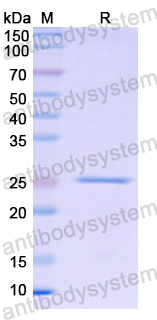Catalog No.
YHC06501
Expression system
E. coli
Species
Homo sapiens (Human)
Protein length
Ile3374-Val3600
Predicted molecular weight
27.48 kDa
Nature
Recombinant
Endotoxin level
Please contact with the lab for this information.
Purity
>90% as determined by SDS-PAGE.
Accession
P04114
Applications
ELISA, Immunogen, SDS-PAGE, WB, Bioactivity testing in progress
Form
Lyophilized
Storage buffer
Lyophilized from a solution in PBS pH 7.4, 0.02% NLS, 1mM EDTA, 4% Trehalose, 1% Mannitol.
Reconstitution
Reconstitute in sterile water for a stock solution. A copy of datasheet will be provided with the products, please refer to it for details.
Shipping
In general, proteins are provided as lyophilized powder/frozen liquid. They are shipped out with dry ice/blue ice unless customers require otherwise.
Stability and Storage
Use a manual defrost freezer and avoid repeated freeze thaw cycles. Store at 2 to 8°C for frequent use. Store at -20 to -80°C for twelve months from the date of receipt.
Alternative Names
Apo B-48, Apo B-100, Apolipoprotein B-100, APOB
Endarachne binghamiae Ameliorates Hepatic Steatosis, Obesity, and Blood Glucose via Modulation of Metabolic Pathways and Oxidative Stress., PMID:40507912
Robust Serum Proteomic Signatures of APOE2., PMID:40501769
Hepatic Inactivation of Carnitine Palmitoyltransferase 1a Lowers ApoB-Containing Lipoproteins in Mice., PMID:40501382
Treatment with orforglipron, an oral glucagon like peptide-1 receptor agonist, is associated with improvements of CV risk biomarkers in participants with type 2 diabetes or obesity without diabetes., PMID:40481478
Apolipoprotein b transcription is driven by ornithine in hepatoma cell lines., PMID:40466366
Helicobacter pylori infection and apolipoprotein B/apolipoprotein A1 ratio: a cross-sectional study., PMID:40463506
Hypertriglyceridemia (>150mg/dL) as a marker of cardiovascular risk., PMID:40461363
Diagnostic significance of clinical scoring system and serum lipid profiles as recovery indicators in ketotic dairy cattle using hormonal-steroids-carbohydrates therapeutic protocol., PMID:40453841
Environmental sulfur and molybdenum stress disrupts mineral homeostasis and induces physiological and molecular alterations in goats., PMID:40451414
Association of Blood Lipoprotein Levels With Incident Alzheimer Disease in Community-Dwelling Individuals: The Framingham Heart Study., PMID:40446198
Crosstalk Between Dietary Fatty Acids and MicroRNAs in the Regulation of Hepatic ApoB-Containing Lipoprotein Synthesis in Humans., PMID:40429957
Body Mass Index as an Example of a Negative Confounder: Evidence and Solutions., PMID:40428387
An evaluation of recaticimab for the treatment of hypercholesterolemia., PMID:40380894
Quantitative proteomic analysis of the protective effect exerted by alliin on ox-LDL-injured HUVECs., PMID:40379781
Association between Apolipoprotein B and diabetic nephropathy: insights from the National Health and Nutrition Examination Survey 2007-2016 and Mendelian randomization analysis., PMID:40379620
Lipid-lowering effect of combined therapy with high-intensity statins and CETP inhibitors: a Systematic Review and meta-analysis., PMID:40375946
Cardiovascular disease risk factors are associated with conventional lipids and apolipoproteins in South African adults of African ancestry., PMID:40375303
Adipocyte metabolic state regulates glial phagocytic function., PMID:40372917
Minigene splicing reporter assay: a high-stake tool for genetic diagnosis in familial hypobetalipoproteinemia., PMID:40367726
The Effect of Increased Plant Protein Intake on the Lipid Profile of Chronic Kidney Disease Patients: A Meta-Analysis of Controlled Clinical Trials., PMID:40362717
An ANGPTL4 inhibitory antibody safely improves lipid profiles in non-human primates., PMID:40360349
[Clinical manifestations and genetic analysis of two patients with familial hypercholesterolemia caused by complex heterozygous variants]., PMID:40350401
RNA interference versus antibody-based PCSK9 inhibition for the prevention of cardiovascular disease: A drug-target Mendelian randomization study., PMID:40347490
Dysregulated serum lipid profile and atherosclerosis in untreated female Takayasu arteritis patients: a propensity score-matched analysis., PMID:40326057
Paraoxonase-like APMAP maintains endoplasmic-reticulum-associated lipid and lipoprotein homeostasis., PMID:40318637
Interleukin-6 modifies Lipoprotein(a) and oxidized phospholipids associated cardiovascular disease risk in a secondary prevention cohort., PMID:40318255
Restricted cubic spline analysis: Age-dependent relationship between MAGEA12 and hepatocellular carcinoma prognosis., PMID:40317152
Revisiting the role of GDF15 in atherosclerosis in mouse and human., PMID:40307459
A Novel Screening Approach for Familial Hypercholesterolemia: A Genetic Study on Patients Detected Using Preexisting Centralized Analytics., PMID:40283609
Dyslipidemia and aging: the non-linear association between atherogenic index of plasma (AIP) and aging acceleration., PMID:40281579
Association of APOB (rs515135) and PCSK9 (rs505151) gene polymorphisms with CAD in the Indian population., PMID:40270278
Guanidinoacetic acid in laying hen diets with varying dietary energy: Productivity, antioxidant status, yolk fatty acid profile, hepatic lipid metabolism, and gut health., PMID:40267570
Dietary Total Antioxidant Capacity Can Modify the Effects of Apo-B Polymorphisms (Ins/Del and EcoRI) on Lipid Profiles and Atherogenic Indices Between Diabetic Patients., PMID:40255178
Association of ApoB/apoA1 ratio with stenosis of intracranial and extracranial arteries in patients with ischaemic stroke., PMID:40253439
Proteomic profiles screening identified novel exosomal protein biomarkers for diagnosis of lung cancer., PMID:40229672
Effects of Blueberry Consumption on Fecal Microbiome Composition and Circulating Metabolites, Lipids, and Lipoproteins in a Randomized Controlled Trial of Older Adults with Overweight or Obesity: The BEACTIVE Trial., PMID:40218958
Effects of a Multimodal Lifestyle Intervention on Cardiometabolic Markers in People with Progressive Multiple Sclerosis: A Secondary Analysis of a Pilot Study., PMID:40218921
Genetically determined increase in apolipoprotein C-III (APOC3 gain-of-function) delays very low-density lipoprotein clearance in humans., PMID:40203662
Effects of saponin extract from Panax notoginseng on hyperlipidemic mice., PMID:40203442
An integrated proteomic classifier to distinguish benign from malignant pulmonary nodules., PMID:40189512
Impaired ApoB secretion triggers enhanced secretion of ApoE to maintain triglyceride homeostasis in hepatoma cells., PMID:40180213
Durability and efficacy of solbinsiran, a GalNAc-conjugated siRNA targeting ANGPTL3, in adults with mixed dyslipidaemia (PROLONG-ANG3): a double-blind, randomised, placebo-controlled, phase 2 trial., PMID:40179932
Reliability of different formulas for estimating plasma Apolipoprotein B levels in a large cohort of South European individuals., PMID:40174303
Tea Polysaccharide Ameliorates Atherosclerosis by Inhibiting Insulin Resistance-Mediated Hepatic VLDL Overproduction., PMID:40173269
The Atherosclerotic Plaque Microenvironment as a Therapeutic Target., PMID:40172727
Genetic Determinants of the Familial Hypercholesterolaemia Phenotype., PMID:40171628
Tafolecimab, a Third Monoclonal Antibody for PCSK9 as the Novel Lipid-Lowering Drug Around the World: A Narrative Review., PMID:40167967
Integrated meta-analysis and network pharmacology analysis: evaluation of Zhigancao decoction as treatment for diabetic cardiomyopathy., PMID:40161384
Distinct lipoprotein contributions to valvular heart disease: Insights from genetic analysis., PMID:40157612
Aromatase reduces sperm motility by down-regulating the expression of proteins related to ATP synthesis in seminal plasma extracellular vesicles., PMID:40155807

